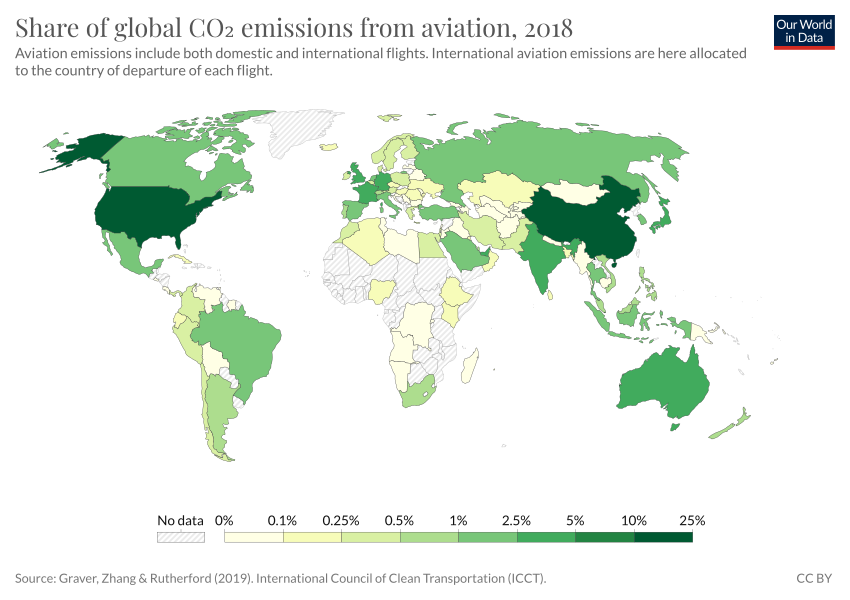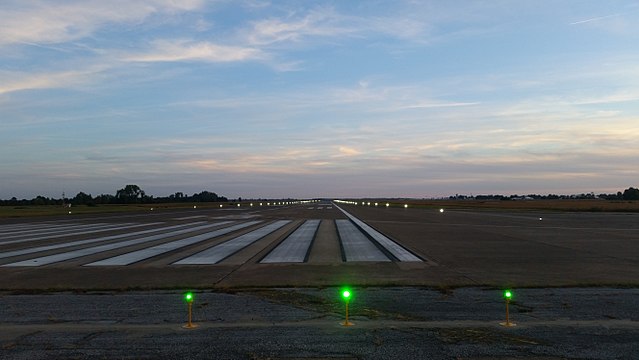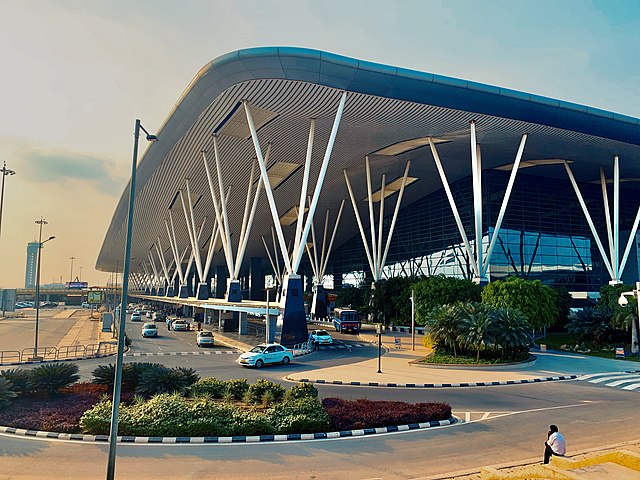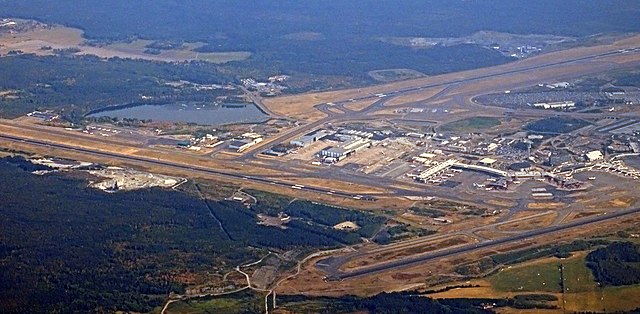Aviation itself is not the enemy of environment, it’s the carbon released by flying that doesn’t help the cause of environment. Historical data indicates that a rise in aircraft flights, related ground support equipment, flight operations, and passenger movements has increased carbon dioxide (CO2) emissions. As the aviation industry’s carbon footprint continues to grow and movements like “Flygskam” discourage flying, airports must prioritize becoming carbon neutral.
One of the ways of doing this might be to use sustainable aviation fuel instead of the traditional jet fuel that is used. The other would be to get rid of fuel tankering. But this is barely scratching the surface. Airports will require significant changes to how they operate if they are to become carbon neutral. But exactly are the methods that airports can use to become Carbon neutral? Let’s find out.

Photo: MassDOT | Wikimedia Commons
Carbon Neutrality & Net Zero: Do you know the difference?
According to the Intergovernmental Panel on Climate Change (IPCC) “when anthropogenic CO2 emissions are balanced globally by anthropogenic CO2 removals over a specific period”, net zero carbon emissions are achieved
Achieving net zero carbon emissions eliminates all emissions. Airports can achieve carbon neutrality by allowing some emissions to remain, as long as they offset those emissions with reductions happening elsewhere.
The net-zero concept does not allow carbon offsetting, i.e. emission reductions are required to a greater degree than carbon neutrality, essentially down to zero.

Photo: Amila Tennakoon | Wikimedia Commons
Current Environmental Impacts of Airports:
The aviation industry causes growing greenhouse gas emissions and air pollution. In 2024, aviation emitted 2.5% of global human carbon emissions annually, with airports contributing 5% of the total. This translates to airports emitting 0.1% of the world’s carbon emissions. While this may seem small, if airport operations, carbon emissions, and operating costs are ignored, they will rise as the number of airports globally increases. Reaching net zero emissions presents a complex challenge for the aviation industry. With their extensive reach and numerous emission sources, airports are a major obstacle to overcome. In response, airports are developing and releasing strategies and action plans to achieve zero greenhouse gas emissions.
Sources of Emissions:
Besides the food waste and emissions by passengers, while traveling back and forth from the airport, the main source of CO2 by airport operators over which they have control are:
- Electricity Consumption: Mainly for heating, cooling, lighting, and servicing terminal and other buildings operated by airlines.
- Boilers: For heating purposes of buildings mentioned above.
- Ground vehicles and support equipment running on diesel petrol etc.

Photo: Our World in Data | Wikimedia Commons
What can be done?
Optimize Energy Efficiency
To optimize energy consumption across various operations, airports can begin by integrating new technologies and practices. Purchasing energy-efficient appliances, intelligent HVAC systems, and LED lighting can be one of the few remedies.
LED lighting can improve safety and visibility at airports while consuming less energy. Airports can use energy more efficiently by having precise control over heating and cooling with smart HVAC systems. The airport’s facilities with energy-efficient equipment and appliances, can reduce overall energy consumption.

Renewable Energy Integration:
Airports’ vast spaces present an opportunity to utilize renewable energy infrastructure. The energy produced from these facilities could not only power airport buildings and internal maintenance but also be fed into the local grid to offset carbon emissions.

Build Sustainable Transport
Airports can integrate sustainable transportation options into their operations as they strive for environmental responsibility. This will help reduce the carbon footprint associated with their operations. Airports can actively promote eco-friendly transportation options. Airport executives should actively promote public transportation, electric car rentals, and on-site bike-sharing programs.
Limit emissions from aircraft on the ground:
An aircraft can consume up to 300 kilograms of fuel between the apron and the runway if both engines are kept on.
While the amount of fuel consumed during taxiing might seem insignificant, there’s still room for improvement. One approach involves optimizing taxiing and apron equipment to minimize fuel use. Another potential solution is to turn off half the engines while the aircraft maneuvers on the ground.
For even greater efficiency, Taxibot remains a frontrunner. This electric vehicle tows the aircraft to the runway or gate, significantly reducing ground emissions. Additionally, many airports offer parking stands with external electricity and air conditioning, further lowering the environmental impact of stationary aircraft.
Manage waste from aircraft operations better
The aviation industry’s environmental impact is under scrutiny due to its substantial waste production and alleged inability to recycle or dispose of it effectively. The execution of zero-waste programs depends on increasing the effectiveness of currently available resources. Waste will increase due to the growth of airport infrastructure and higher passenger traffic. To reduce waste in this setting, airports need strategic planning and efficient resource allocation. No waste will be entirely disposed of if a zero-waste strategy is successful.
Using Green Building Practices
Airports should implement green building techniques to reduce their environmental impact. Green building practices use sustainable design principles and eco-friendly materials in the construction and renovation of buildings. An approach like this helps create an infrastructure that is more energy-efficient and resilient.
Utilizing locally produced, recycled, or reclaimed building materials is a top priority for green airports. Utilizing recycled materials promotes a circular economy and lessens the environmental impact of conventional buildings.

Water Conservation Measures
Airports can take several actions to support water conservation initiatives. Airport facilities can use less water by implementing water-saving technologies like smart irrigation systems and low-flow fixtures.
To enhance sustainability further, airports can explore alternative water sources like rainwater harvesting (RWH) and greywater reuse systems. These methods can help reduce reliance on traditional water supplies. Additionally, conducting regular water audits allows airports to pinpoint areas for improved efficiency.
What is being done? – Some case studies
- In the Dominican Republic, concessionaire VINCI Airports has emerged as the top private generator of electricity derived from renewable sources, and there are currently photovoltaic power plants in Salvador de Bahia in Brazil, France, Serbia, Portugal, Japan, and the Dominican Republic. The installed capacity of these facilities currently exceeds 44 MW. Renewable energy sources provide airports with carbon-free energy for their internal operations. Additionally, the electricity generated from these sources feeds into the local grid, supporting the transition towards clean energy in regions that sometimes rely on fossil fuels.
- Hamad International Airport of Qatar produces more than 3,000 tons of organic compost annually from recycling landscaping wastes. This compost is sold to outside parties and used for internal green initiatives. It collaborates with the Municipality Minister to improve recycling and wastewater treatment procedures. In 2014, the airport constructed a wastewater treatment plant to handle all generated wastewater. With over 1,000 tonnes of segregated plastic waste, 81% of the airport’s waste was recycled, reused, or turned into energy between April 2023 and March 2024, making it one of the highest conversion rates in the airport industry.

- Gatwick Airport, UK was the first to receive the Carbon Trust’s Zero Waste to Landfill certification in 2018 as it actively diverts its non-hazardous waste from landfills.In 2019, the airport recycled over 40% of the garbage it produced The airport spent over $3 million building a facility for converting waste into energy and can internally process and reduce waste thanks to this facility.
- Bengaluru Kempegowda International Airport (BLR) of India started investing in developing a waste management system in-house in 2018. The system can process 20 tonnes of waste daily, expandable to 60 tonnes

- Founded in 1914 in Kansas City, Missouri, HNTB Corporation is an American Infrastructure Design Firm, that has been widely reusing old materials in new developments. As HNTB’s aviation project director and vice president, Julie Wienberg puts it: “On all our airport projects that include demolition, we specify the recycling of as much demolished material as possible. This includes recycling pavement as a sub-base for new airport runways, taxiways, and aprons. It also includes recycling metals such as aluminum, steel, and copper.”
International Commitments towards carbon neutral airports:
- With its headquarters in Brussels, the Airports Council International(ACI) is a global association of over 2,000 airports that works to promote best practices globally and advance the aviation industry.

Its members pledged in June 2019 to achieve net zero carbon emissions by 2050 for all activities under their control—without using offsets.
- European airports agreed towards carbon removal and storage to offset any residual emissions and minimize their absolute emissions to the greatest extent feasible to meet their commitment. This implies that airports must cut their emissions—ideally to zero—to meet the Net Zero 2050 commitment.
As of June 2023, 324 airports operated by 104 operators in 38 European countries had committed to achieve Net Zero carbon emissions from operations under their control by 2050 at the latest; 132 airports had established a target date of no later than 2030. Ten Swedavia-operated airports in Sweden have already attained net zero carbon emissions, even without any carbon removal. These are Bromma, Göteborg Landvetter, Stockholm Arlanda, Stockholm, Malmö, Umeå, Luleå, Åre Östersund, Ronneby, Visby, and Kiruna. Since 2019, Luleå, Ronneby, and Visby have operated without using any fossil fuels.

Airport Carbon Accrediation(ACA)
The aviation industry’s response to climate change has advanced significantly with the introduction of Airport Carbon Accreditation (ACA) Level 5. This strict framework aligns with global decarbonization goals by providing a clear route for airports to reach net zero carbon emissions.
The Airport Carbon Accreditation (ACA) program stands alone as the only globally recognized certification for airport carbon management that enjoys institutional backing. Through seven certification levels—”Mapping,” “Reduction,” “Optimization,” “Neutrality,” “Transformation,” “Transition,” and “Level 5″—it independently evaluates and acknowledges airports’ efforts to manage and lower their carbon emissions. With quantifiable outcomes, the program offers a special common framework and tool for proactive carbon management at airports.
Currently accounting for 54.5% of all air traffic worldwide, 571 airports have been recognized as Airport Carbon Accredited worldwide. With 58 carbon-neutral airports, that number represents an annual reduction of well over 322,000 tonnes of CO2.

Challenges surrounding carbon-neutral airports
The aviation industry is a multi-billion dollar industry, and airports are one of the major parts of it. Transforming airports into carbon-neutral infrastructure is challenging. There are many challenges and hindrances around it.
- Infrastructure: To achieve carbon neutrality, airports may need to upgrade or repurpose their existing energy infrastructure. This may include changing electrical transmission and distribution systems to handle more variable and high loads, costing a fortune to airports.
- Physical constraints: Airports may struggle with space constraints for installing on-site energy generation and storage.
- Cost: Lack of funding and support from governing bodies may hinder airports in securing the capital needed to achieve net-zero emissions. The cost incurred by airports in attaining net zero may later on reflect on the air ticket prices, decreasing their sales.
In essence, achieving carbon-neutral airports presents a complex challenge, demanding a holistic strategy that encompasses various solutions. While the aviation sector’s contribution to global emissions might seem relatively small, its impact on environmental sustainability is undeniable. Therefore, airports have a significant responsibility to reduce their carbon footprint. By implementing a combination of energy-efficiency measures, renewable energy integration, sustainable transportation initiatives, and innovative waste management techniques, airports can make significant strides towards a more sustainable future.

By implementing various energy-efficiency measures, integrating renewable energy sources, pursuing sustainable transportation initiatives, and employing innovative waste management techniques, airports can make significant strides towards a more sustainable future.. Additionally, implementing water-saving techniques and green building principles can improve the sustainability of airport operations. We can explore the viability and advantages of these tactics through case studies from numerous airports across the globe. The evidence is clear: focused efforts can result in significant environmental gains. Examples include the solar power initiatives in the Dominican Republic and the advanced waste management systems and zero waste at Hamad International Airport and Bengaluru Kempegowda International Airport.
Airports can attain carbon neutrality and ultimately net zero emissions through a structured pathway made possible by international commitments and certifications. One of those is from the Airports Council International (ACI) and Airport Carbon Accreditation (ACA). The aviation industry is moving toward a more sustainable future, and this requires the cooperation of all stakeholders on a global scale.
However, achieving carbon neutrality is not without difficulties. Despite these challenges, airports can still set the standard for lowering the environmental impact of the aviation sector. By coordinating with larger global decarbonization initiatives, airports can play a crucial role. Through sustained innovation, investment, and dedication, they can ultimately guarantee a more sustainable future for all.
References:
Choufani, E.E. (no date) Energy reduction in airports. Available at: https://www.cibse.org/media/pngijmy2/energy-reduction-in-airports-2016-1.pdf (Accessed: 14 June 2024).
Energy Transitions Commission, 2018. Mission Possible: reaching net-zero carbon emissions from harder-to-abate sectors by mid-century. Energy Transitions Commission.
Photo of “Co2 emissions fraction of aviation %” was, according to the description of the image in Wikimedia Commons, “charted with google docs, with data retrieved with WebPlotDigitizer from David S. Lee (9 February 2020), “The contribution of global aviation to anthropogenic climate forcing for 2000 to 2018”, in Atmospheric Environment”
